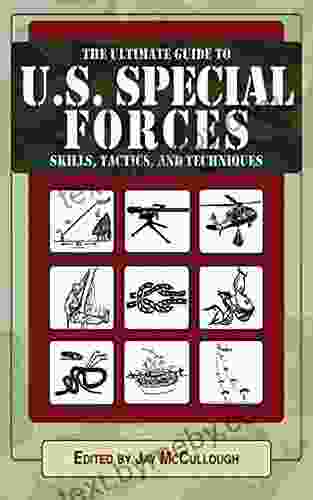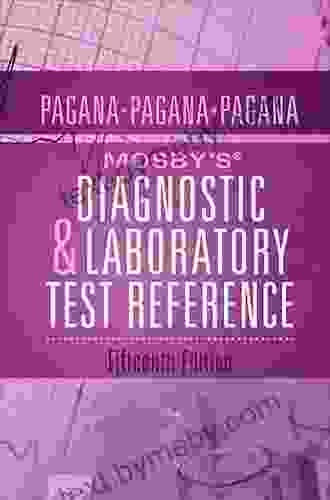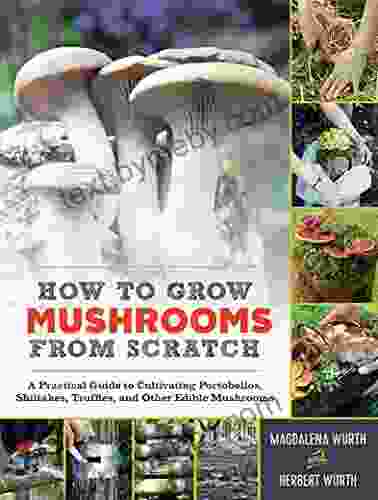The Ultimate Guide to Cultivating Portobellos, Shiitakes, Truffles, and Other Edible Mushrooms

Are you looking to grow your own gourmet mushrooms at home? This practical guide will teach you everything you need to know about cultivating portobellos, shiitakes, truffles, and other edible mushrooms. From choosing the right substrate and spawn to controlling the temperature and humidity, we'll cover all the essential steps to help you grow your own delicious and nutritious mushrooms.
4.5 out of 5
| Language | : | English |
| File size | : | 28437 KB |
| Text-to-Speech | : | Enabled |
| Enhanced typesetting | : | Enabled |
| Word Wise | : | Enabled |
| Print length | : | 144 pages |
| Lending | : | Enabled |
| Screen Reader | : | Supported |
Benefits of Cultivating Edible Mushrooms
There are many benefits to cultivating your own edible mushrooms, including:
- Cost savings: Growing your own mushrooms can save you a lot of money compared to buying them at the store.
- Freshness: Home-grown mushrooms are always fresh and flavorful.
- Nutritional value: Mushrooms are a good source of protein, fiber, and vitamins.
- Convenience: You can grow mushrooms in your own home, so you can always have them on hand.
- Fun: Growing mushrooms is a fun and rewarding experience. It's a great way to learn about nature and science.
Choosing the Right Substrate and Spawn
The first step in cultivating mushrooms is to choose the right substrate and spawn. The substrate is the material that the mushrooms will grow in, and the spawn is the mycelium that will produce the mushrooms.
There are many different types of substrate that can be used to grow mushrooms, including straw, sawdust, wood chips, and compost. The best substrate for you will depend on the type of mushrooms you want to grow and the climate you live in.
Spawn is available in two forms: liquid culture and grain spawn. Liquid culture is a suspension of mycelium in water, while grain spawn is mycelium that has been grown on grains. Grain spawn is more commonly used for home cultivation, as it is easier to handle and less likely to contaminate.
Preparing the Substrate
Once you have chosen your substrate and spawn, you need to prepare the substrate. This involves moistening the substrate and adding any necessary nutrients.
The amount of moisture you need to add to the substrate will depend on the type of substrate you are using. Straw and sawdust need to be moistened more than wood chips or compost.
You can add nutrients to the substrate by mixing in things like coffee grounds, manure, or bone meal. This will help the mushrooms to grow and produce more fruit.
Spawning the Substrate
Once the substrate is prepared, you need to spawn it with the mycelium. This involves mixing the spawn into the substrate evenly.
The amount of spawn you need to use will depend on the type of mushrooms you are growing and the size of your grow container. For most mushrooms, you will need to use about 1 pint of spawn per 5 gallons of substrate.
Incubating the Substrate
After the substrate has been spawned, it needs to be incubated. This means keeping the substrate warm and humid so that the mycelium can grow.
The ideal incubation temperature for most mushrooms is between 70 and 80 degrees Fahrenheit. The humidity should be kept at around 90%.
You can incubate the substrate in a variety of ways, including:
- In a plastic bag: Place the substrate in a plastic bag and seal it shut. Puncture a few holes in the bag for ventilation.
- In a grow box: A grow box is a specialized container that is designed for incubating mushrooms. Grow boxes are typically made of polystyrene or plastic and have built-in holes for ventilation.
- In a Martha tent: A Martha tent is a large, enclosed space that is used to incubate mushrooms. Martha tents are typically made of plastic or canvas and have a humidifier to keep the humidity high.
The incubation period will vary depending on the type of mushrooms you are growing and the temperature and humidity of your incubation environment. Most mushrooms will incubate for 2 to 3 weeks.
Fruiting the Mushrooms
Once the mycelium has colonized the substrate, it will begin to produce mushrooms. This process is called fruiting.
To fruit mushrooms, you need to provide them with fresh air and light. You can do this by opening the lid of your incubation container or by moving the container to a well-lit area.
The mushrooms will typically begin to fruit within a few days of being exposed to fresh air and light. The fruiting period will last for several weeks, and you will need to harvest the mushrooms as they mature.
Harvesting the Mushrooms
When the mushrooms are mature, they are ready to be harvested. To harvest mushrooms, gently twist them off the substrate. Do not pull the mushrooms, as this can damage the mycelium.
Once you have harvested the mushrooms, you can store them in the refrigerator for up to a week. Mushrooms can also be dried or frozen for longer storage.
Troubleshooting
There are a few common problems that you may encounter when cultivating mushrooms. These problems can be caused by a variety of factors, including contamination, improper temperature and humidity, and pests.
Contamination
One of the most common problems in mushroom cultivation is contamination. Contamination can be caused by a variety of microorganisms, including bacteria, fungi, and molds.
To prevent contamination, it is important to use sterile equipment and to keep your grow area clean. You should also avoid opening your incubation container too often, as this can introduce contaminants.
Improper Temperature and Humidity
Mushrooms require a specific temperature and humidity range to grow properly. If the temperature is too high or too low, the mushrooms will not grow or will produce deformed fruit. Similarly, if the humidity is too low, the mushrooms will dry out and
4.5 out of 5
| Language | : | English |
| File size | : | 28437 KB |
| Text-to-Speech | : | Enabled |
| Enhanced typesetting | : | Enabled |
| Word Wise | : | Enabled |
| Print length | : | 144 pages |
| Lending | : | Enabled |
| Screen Reader | : | Supported |
Do you want to contribute by writing guest posts on this blog?
Please contact us and send us a resume of previous articles that you have written.
 Book
Book Novel
Novel Page
Page Chapter
Chapter Text
Text Story
Story Genre
Genre Reader
Reader Library
Library Paperback
Paperback E-book
E-book Magazine
Magazine Newspaper
Newspaper Paragraph
Paragraph Sentence
Sentence Bookmark
Bookmark Shelf
Shelf Glossary
Glossary Bibliography
Bibliography Foreword
Foreword Preface
Preface Synopsis
Synopsis Annotation
Annotation Footnote
Footnote Manuscript
Manuscript Scroll
Scroll Codex
Codex Tome
Tome Bestseller
Bestseller Classics
Classics Library card
Library card Narrative
Narrative Biography
Biography Autobiography
Autobiography Memoir
Memoir Reference
Reference Encyclopedia
Encyclopedia Maria Dahvana Headley
Maria Dahvana Headley Marc Silver
Marc Silver Stuart Clark
Stuart Clark Lutz Warsitz
Lutz Warsitz Peter J Seybolt
Peter J Seybolt Nathan Jendrick
Nathan Jendrick Veronica Sekules
Veronica Sekules Lucy Hopping
Lucy Hopping Liz Van Pay
Liz Van Pay Sharon Rowley
Sharon Rowley William Hazlitt
William Hazlitt John Lister Kaye
John Lister Kaye Prasad Raju V V N R Pathapati
Prasad Raju V V N R Pathapati Robert Carmichael
Robert Carmichael Rob Neyer
Rob Neyer Lyndsay Campbell
Lyndsay Campbell Richard Paul Russo
Richard Paul Russo Marilyn Ann Moss
Marilyn Ann Moss Marina Robb
Marina Robb Tracy Brown
Tracy Brown
Light bulbAdvertise smarter! Our strategic ad space ensures maximum exposure. Reserve your spot today!
 Rudyard KiplingFollow ·11.5k
Rudyard KiplingFollow ·11.5k Samuel WardFollow ·4k
Samuel WardFollow ·4k Desmond FosterFollow ·2.9k
Desmond FosterFollow ·2.9k Braeden HayesFollow ·7.1k
Braeden HayesFollow ·7.1k Giovanni MitchellFollow ·12k
Giovanni MitchellFollow ·12k Arthur C. ClarkeFollow ·16.4k
Arthur C. ClarkeFollow ·16.4k H.G. WellsFollow ·3.2k
H.G. WellsFollow ·3.2k Houston PowellFollow ·16.1k
Houston PowellFollow ·16.1k

 Clay Powell
Clay Powell20 Must Visit Attractions In La Paz, Bolivia
La Paz, Bolivia...

 Giovanni Mitchell
Giovanni MitchellUltimate Guide to Special Forces Skills, Tactics, and...
The world of...

 Joseph Heller
Joseph HellerThe Texas Ranger and Hunter Illustrated: A Visual Journey...
Prepare to embark on an...

 José Martí
José MartíThe Secrets and Science of Ads That Sell More: A...
Are you struggling to create...

 Eli Blair
Eli BlairAdolescents and Their Families: A Comprehensive Guide for...
Adolescence,...

 Neil Gaiman
Neil GaimanMosby Diagnostic and Laboratory Test Reference: The...
In the dynamic healthcare landscape, staying...
4.5 out of 5
| Language | : | English |
| File size | : | 28437 KB |
| Text-to-Speech | : | Enabled |
| Enhanced typesetting | : | Enabled |
| Word Wise | : | Enabled |
| Print length | : | 144 pages |
| Lending | : | Enabled |
| Screen Reader | : | Supported |












